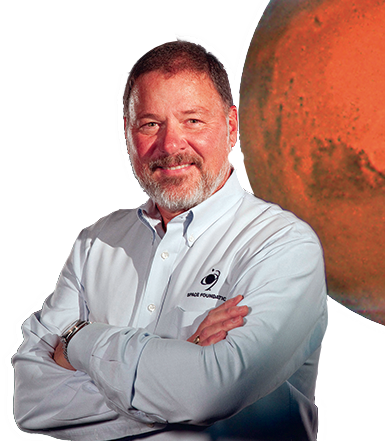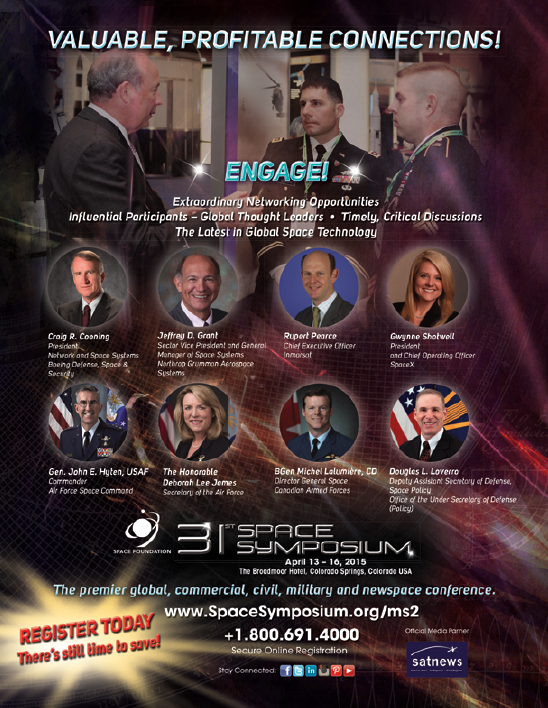2014 was a very good year for space.

Not great. Not perfect. Not without a stumble here and there. But, overall, a very good year—one that we can build upon.
I know this because at the end of each calendar year, right before the holiday break, the Space Foundation works through the process of short-listing worthy candidates for the awards that we present at the annual Space Symposium.
Sometimes the exercise is difficult, and we find ourselves beating the bushes for ideas. At other times, the pickings are so slim that we aren’t able to present an award in one category or another.
But, then, there are years like 2014, where there are multiple potential award winners all across the global space enterprise—for space achievement, public outreach, space exploration and STEM education.
When you find yourself murder-boarding the short lists, and moderating passionate debates about the merits of the candidates, you know it has been a stellar year.
Don’t look for me to give away any secrets about our award winners just yet. We’re in the process of notifying them, and we’ll announce each award in due course. However, if you haven’t already made your plans to attend the 31st Space Symposium in April, you’re going to want to get those plans in order pretty quick. You’re not going to want to miss this!
Why do I think 2015 is going to be better?
For one thing, 2015 is the year that most people in our industry are going to get over ITAR. That may sound weird, because most of the significant ITAR reform we’ve been banging our gongs about for years did, in fact, finally get across the finish line in 2014—only to hear people singing the same old “woe is ITAR, woe is me!” song over the last several months of the year. You’d think that nobody got the news. In the vernacular of the season just passed, “Yes, Virginia, there is ITAR reform!”
Of course, something like ITAR reform can never go far enough for some people, but where we are today is a good place. The U.S., and other countries, of course, still protects those exquisite and sensitive technologies that ought to be controlled.
The State Department and others have their bald, hairy eyeballs on that—as they should. But the parts and pieces and components that should be traded freely and competitively are back on the market; regulation of them, from the U.S. side, is back at the Commerce Department. I had one customer recently confide, quite giddily, that 100 percent of his company’s products and services had moved from the ITAR list to the Commerce list.
That means it is time to stop making complaints and start making deals. This will happen in 2015, which will be very good for business.
Another reason that 2015 is going to be a very good year in space is that the U.S. and China—finally—have begun talking to one another on certain space matters. Now, this is not the same as détente, and it is not yet opening the floodgates of collaboration and trade, but it is a start.
For nearly a decade, the Space Foundation has been rather a lone voice in the wilderness in terms of our willingness to collaborate with our friends and colleagues in the People’s Republic. (Shout out to our friends at Secure World Foundation and the United Nations Office for Outer Space Affairs, who have also kept this lamp burning.) But recent diplomacy has cracked open the door for some basic communication about human and civil space programs.
The U.S. appears to be on a path to sharing SSA and conjunction analysis data with our colleagues in China. These are very, very small and tentative steps. But they are a start.
Civil space programs certainly seem poised for a good year, too. In the U.S., Congress ended 2014 by passing a 2015 spending bill that provides about $500 million more for NASA than the White House requested. This money will be important to continuing the momentum of the commercial cargo and commercial crew programs at NASA, as well as keeping Orion and SLS on track in the wake of the stunning year-end success of Exploration Flight Test 1.
The same week as EFT-1, our colleagues in Europe conducted a hugely successful and important ESA ministerial meeting—which solidified ESA support for further utilization of the International Space Station, and finally settled the long-running Franco-Germanic dispute on the future of Europe’s launcher programs.
Japan’s exploration program continues to move forward with the recent launch of Hayabusa-2; form and detail is beginning to emerge around the establishment, in 2014, of the United Arab Emirates space agency; South Korea’s space plans should move forward in the wake of first-ever space bilateral meetings held a few months ago with the U.S.—and the beat goes on.
The small but important launch sector is also poised for greatness in 2015. As already mentioned, the way forward for Europe has been found. Now it just remains to be seen whether powerful, strike-happy unions in Europe will embrace the deal, or torch it. SpaceX, of course, continues to rock the boat—this time, quite literally, by planning to land a four-legged Falcon 9 first stage on a sea-going barge.
Nor is SpaceX the only company chasing the Holy Grail of re-usability, as Amazon.com founder Jeff Bezos’ clandestine Blue Origin is preparing for a critical test flight of New Shepherd-related hardware
Blue Origin is also teamed with United Launch Alliance after a stunning announcement a few months back that the upstart start-up will produce new main engines for the Atlas 5. And all my friends at ULA and Air Force Space Command are going to cringe and go running for wood to knock their knuckles upon, but you heard it here first: ULA is on pace to rack up its 100th consecutive successful launch later this year, with an August mission of the Atlas V out of SLC-41 at Cape Canaveral.
The late-December launch by ILS of the Yamal 401 satellite, from Kazakhstan, on a commercial Proton, certainly fuels hope that Russia’s troubled Proton program is back on track—something ILS is counting on, with a backlog of commercial satellites on dock for 2015.
If there’s a potential cloud in the generally sunny space forecast for 2015, that cloud hangs over the future of Russian space programs—which is anything but certain in the current geopolitical environment. Isolated by the international community, Russia’s path forward in space is anything but clear, and on any given day the west is either (A) no longer buying Russian engines, (B) signing new deals to buy new Russian engines, or (C) both.
While Russia’s role in the ISS seems stable, there are sporadic threats of withdrawal from the program, or that Russia will launch its own station. Europe’s new launcher policy is also seen by some as the beginning of the end of Russia’s brief adventure in launching Soyuz from the Kourou spaceport in French Guyana.
Too seldom discussed is the impact of all this on our friends in Ukraine—who have such a deep history and capability in space; Kyiv and Dnepepetrovsk need the west to step up to greater partnerships going forward.
At $314 billion in turnover in 2013, the global space industry is clearly too large and too diverse to comment upon every sector within the editorial confines of this newsletter. Generally speaking, I think we’re going to see the commercial side of the business, especially downstream and value-added applications, grow nicely in 2015.
Commercial SATCOM will continue to dominate space commerce, especially if traditionally inefficient government customers can learn new ways of doing business—which they must, in view of continuing government budget pressures. Those budget pressures are also telling government to divest itself of some of its “pet rocks,” and turn to efficient, experienced commercial operators to conduct routine space operations.
The blossoming commercial space start-up sector will continue to excite and attract new investment. Personal space flight will maintain its momentum, as some players recover from 2014 setbacks and other players continue their forward progress.
Space is the most exciting business in the world. And while the start of a new year is always a cause for optimism, we have more to be upbeat about than most.
The View from Here is that 2014 was a good year for space—and 2015 will be even better.

Named chief executive officer of the Space Foundation in 2001, Elliot Pulham leads a premier team of space and education professionals providing services to educators and students, government officials, news media and the space industry around the world. He is widely quoted by national, international and trade media in coverage of space activities and space-related issues. Before joining the Space Foundation, he was senior manager of public relations, employee communication and advertising for all space programs of Boeing, serving as spokesperson at the Kennedy Space Center for the Magellan, Galileo and Ulysses interplanetary missions, among others. He is a recipient of the coveted Silver Anvil Award from the Public Relations Society of America - the profession’s highest honor. In 2003, the Rotary National Awards for Space Achievement Foundation presented him with the coveted Space Communicator Award, an honor he shares with the late legendary CBS News Anchor Walter Cronkite and former CNN News Anchor Miles O’Brien. Pulham is a former Air Force Civic Leader and advisor to the Chief of Staff and Secretary of the Air Force and a recipient of the U.S. Air Force Distinguished Public Service Medal. He serves on the editorial board of New Space Journal.



